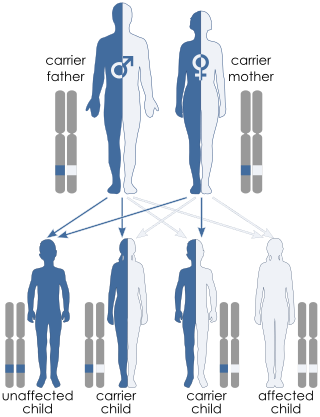
Waardenburg syndrome is a group of rare genetic conditions characterised by at least some degree of congenital hearing loss and pigmentation deficiencies, which can include bright blue eyes, a white forelock or patches of light skin. These basic features constitute type 2 of the condition; in type 1, there is also a wider gap between the inner corners of the eyes called telecanthus, or dystopia canthorum. In type 3, which is rare, the arms and hands are also malformed, with permanent finger contractures or fused fingers, while in type 4, the person also has Hirschsprung's disease. There also exist at least two types that can result in central nervous system (CNS) symptoms such as developmental delay and muscle tone abnormalities.

Barakat syndrome is a rare disease characterized by hypoparathyroidism, sensorineural deafness and renal disease, and hence also known as HDR syndrome. It is an autosomal dominant condition with incomplete penetrance and variable expressivity that was first described by Amin J. Barakat et al. in 1977.

Alström syndrome (AS), also called Alström–Hallgren syndrome, is a very rare autosomal recessive genetic disorder characterised by childhood obesity and multiple organ dysfunction. Symptoms include early-onset type 2 diabetes, cone-rod dystrophy resulting in blindness, sensorineural hearing loss and dilated cardiomyopathy. Endocrine disorders typically also occur, such as hypergonadotrophic hypogonadism and hypothyroidism, as well as acanthosis nigricans resulting from hyperinsulinemia. Developmental delay is seen in almost half of people with Alström syndrome.

Sodium bicarbonate transporter-like protein 11 is a protein that in humans is encoded by the SLC4A11 gene.

Björnstad syndrome is an autosomal recessive congenital condition involving pili torti, sensorineural deafness, and hair abnormalities. It was first characterized in 1965, in Oslo, by prof. Roar Theodor Bjørnstad after he observed an association between pili torti and hearing loss. The condition is extremely rare, with less than 50 cases documented in medical literature worldwide.
EAST syndrome is a syndrome consisting of epilepsy, ataxia, sensorineural deafness and salt-wasting renal tubulopathy. The tubulopathy in this condition predispose to hypokalemic metabolic alkalosis with normal blood pressure. Hypomagnesemia may also be present.

Mohr–Tranebjærg syndrome (MTS) is a rare X-linked recessive syndrome also known as deafness–dystonia syndrome and caused by mutation in the TIMM8A gene. It is characterized by clinical manifestations commencing with early childhood onset hearing loss, followed by adolescent onset progressive or , visual impairment from early adulthood onwards and dementia from the 4th decade onwards. The severity of the symptoms may vary, but they progress usually to severe deafness and dystonia and sometimes are accompanied by cortical deterioration of vision and mental deterioration.
Ocular albinism late onset sensorineural deafness (OASD) is a rare, X-linked recessive disease characterized by intense visual impairments, reduced retinal pigments, translucent pale-blue irises and moderately severe hearing loss from adolescence to middle-age. It is a subtype of Ocular Albinism (OA) that is linked to Ocular albinism type I (OA1). OA1 is the most common form of ocular albinism, affecting at least 1/60,000 males.
Autosomal dominant cerebellar ataxia, deafness, and narcolepsy (ADCADN) is a rare progressive genetic disorder that primarily affects the nervous system and is characterized by sensorineural hearing loss, narcolepsy with cataplexy, and dementia later in life. People with this disorder usually start showing symptoms when they are in their early-mid adulthoods. It is a type of autosomal dominant cerebellar ataxia.

Chudley–Mccullough syndrome is a rare genetic disorder which is characterized by bilateral congenital hearing loss associated with brain malformations. It is a type of syndromic deafness.

Waardenburg anophthalmia syndrome is a rare autosomal recessive genetic disorder which is characterized by either microphthalmia or anophthalmia, osseous synostosis, ectrodactylism, polydactylism, and syndactylism. So far, 29 cases from families in Brazil, Italy, Turkey, and Lebanon have been reported worldwide. This condition is caused by homozygous mutations in the SMOC1 gene, in chromosome 14.

Thickened earlobes-conductive deafness syndrome, also known as Escher-Hirt syndrome, or Schweitzer Kemink Graham syndrome, is a rare genetic disorder which is characterized by ear and jaw abnormalities associated with progressive hearing loss. Two families worldwide have been described with the disorder.

Amaurosis congenita, cone-rod type, with congenital hypertrichosis is a very rare genetic disorder which is characterized by ocular anomalies and trichomegaly. It is inherited in an autosomal recessive manner. Only 2 cases have been described in medical literature.
Palmoplantar keratoderma with deafness, also known as Palmoplantar keratoderma-deafness syndrome is a rare genetic disorder which is characterized by either focal or diffuse early-onset palmoplantar keratoderma and sensorineural deafness. Transmission is autosomal dominant with incomplete penetrance.
CAPOS syndrome is a rare genetic neurological disorder which is characterized by abnormalities of the feet, eyes and brain which affect their normal function. These symptoms occur episodically when a fever-related infection is present within the body. The name is an acronym for "cerebellar ataxia, areflexia, pes cavus, optic atrophy, and sensorineural hearing loss".
X-linked Charcot–Marie–Tooth disease is a group of genetic disorders and a type of Charcot–Marie–Tooth disease characterized by sensory loss associated with muscle weakness and atrophy alongside many other symptoms.

Goldmann–Favre syndrome is a rare genetic disorder characterized by early-onset nyctalopia, decreased visual acuity, and abnormal findings of the fundus. It is a type of progressive vitreotapetoretinal degeneration.

Odontoonychodermal dysplasia is a rare genetic disorder which is characterized by systemic abnormalities of the teeth, the nails of the fingers and toes, the skin, the hair cells, and the sweat glands. It is a type of syndromic ectodermal dysplasia.

Wolfram-like syndrome is a rare autosomal dominant genetic disorder that shares some of the features shown by those affected with the autosomal recessive Wolfram syndrome. It is a type of WFS1-related disorder.









